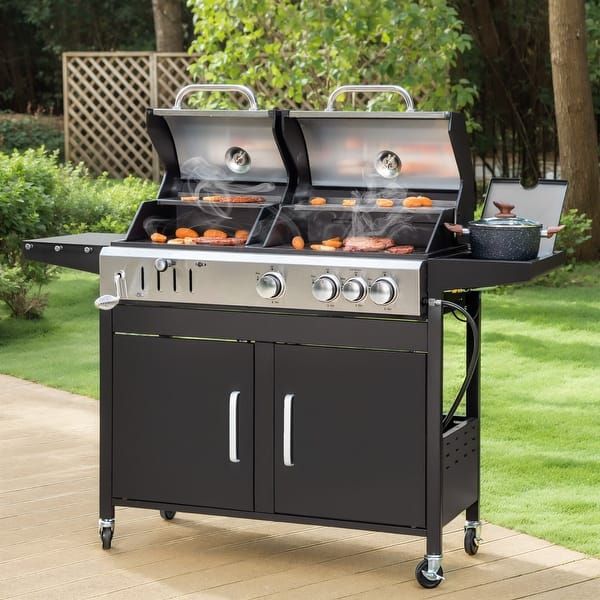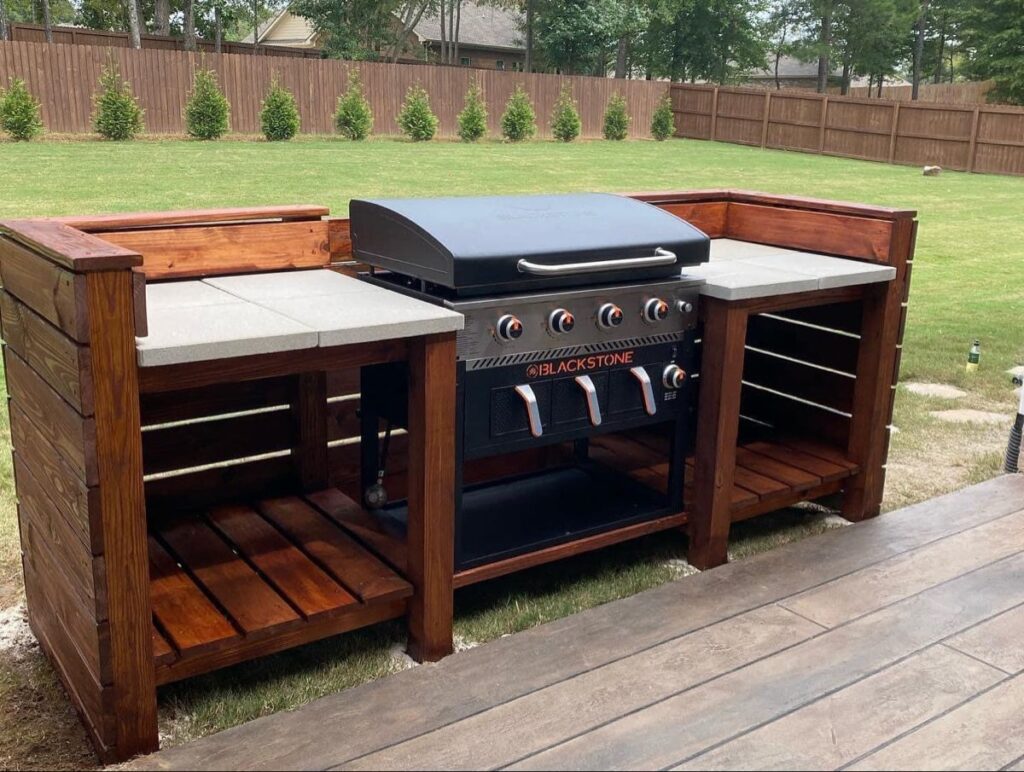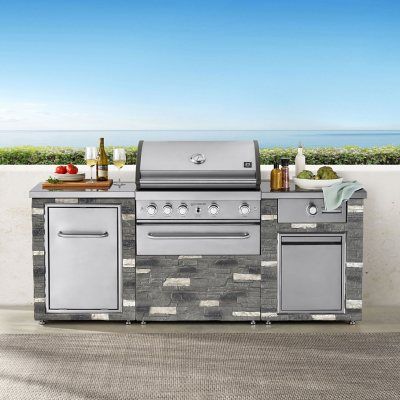The sun drops behind the fence, your stomach calls, and the clock says you have forty minutes before the kids start asking “What’s for dinner?” That tight window is why more home cooks reach for a propane lid instead of lighting a pile of briquettes. Speed, control, and a tidy deck all matter when weeknights move fast.
The short answer: a modern gas grill wins for most backyards because it starts in seconds, holds steady heat with little fuss, and cleans up with a wipe.
Fire lovers still praise charcoal’s smoke, yet many end up using it only on long weekends. If you grill three nights a week, the math, the mess, and the effort all tilt toward gas. Dive in below to see how each factor plays out and decide if 2025 is your year to switch.
A question-and-answer path follows. Each section picks one real search query and unpacks it with clear facts. By the end, you will know exactly which grill fits your space, budget, and cooking style.

Why Choose Gas Grills for Quick Weeknight Meals?
Your boss kept you late, the kids have homework, and no one wants take-out again. In that rush, pressing a single ignition button feels like magic.
Yes. A gas grill can be ready to cook in under ten minutes, while charcoal often needs thirty.
Speed Matters
| Step to 500 °F | Gas | Charcoal |
|---|---|---|
| Prep fuel | Turn knob | Pour briquettes |
| Ignite | Push button | Light chimney |
| Warm-up (avg.) | 6 min | 25 min |
| Ready to cook | ≤ 10 min | ~30 min |
A stainless firebox with tube burners spreads heat fast. Vaporizer bars sit above each burner, turning drips into flavor vapor without slowing warm-up. In side-by-side tests from Cook’s Illustrated and Wirecutter, four-burner gas models held pizza-ready heat in eight minutes. By contrast, chimney-lit hardwood lump took 23 to ash over and another five to settle.
Time savings stack up. Three weekday dinners a week equals 90 starts a summer. Swapping charcoal for gas can save about 30 hours of waiting by September. That extra time can cover cleanup, bedtime stories, or just sitting down.
Smaller details help, too. Built-in lid thermometers confirm temperature at a glance. You close the lid, check the dial, and adjust flame in seconds. No need to spread coals or raise grates. All this turns grilling from a special project into a normal way to cook supper.
Does Propane Grilling Cut Cooking Costs Long-Term?
Fuel price feels small per night, yet it adds up across a season. Shoppers weigh the cylinder refill against bags of lump or briquettes.
On average, propane costs 20 % less per meal than branded hardwood charcoal when you grill often.
Fuel Cost per Cook
| Item | Unit Price (USA avg.) | Meals per Unit | Cost per Meal |
|---|---|---|---|
| 20 lb propane refill | \$19 | ~18 | \$1.05 |
| 15 lb hardwood lump bag | \$17 | 10 | \$1.70 |
| 16 lb briquettes bag | \$12 | 12 | \$1.00 |
Propane’s edge grows with frequency. A full cylinder can outlast two weeks of nightly dinners. Charcoal buyers tote heavy bags from the store and toss ash after every session. Over a July-to-October stretch (roughly 60 cooks), propane users might spend \$63. Charcoal fans buy five or six bags, landing near \$102.
Maintenance costs lean gas as well. Stainless flavorizer bars last years, whereas ceramic charcoal grates crack under high heat. Add the price of fire starters and chimney soot on clothes, and gas wins in dollars and hassle.
Bulk natural-gas hook-ups widen the gap further. Municipal supply averages just 50 ¢ per cook, slashing fuel bills below even oven use. If your patio has a stub-out, a fixed NG grill pays back the plumber’s work in two summers.

Can Gas Burners Deliver Consistent Steakhouse Sear?
Charcoal lovers swear by 700 °F walls of radiant heat. Gas owners fear pale steaks. Reality is kinder to gas than rumor suggests.
Yes. Multi-port tube burners and infrared plates let a gas grill match or beat the sear power of most kettle grills.
Heat Zone Breakdown
| Grill Type | Peak Center Temp | Edge Temp | Zone Control |
|---|---|---|---|
| Four-burner gas + sear plate | 725 °F | 380 °F | 4 knobs |
| Standard kettle charcoal | 680 °F | 250 °F | 1 coal pile |
| Two-burner portable gas | 650 °F | 350 °F | 2 knobs |
Modern models include ceramic sear stations. They fire a narrow strip above 700 °F, browning rib-eyes in 60 seconds per side. Slide meat left or right and settle at 450 °F to finish without burning. That two-zone method beats single-height charcoal grates, where distance control means lifting or lowering the whole cook surface.
Even mid-price gas carts now reach 50,000 BTU total. Combine high flow with a lid that seals heat, and you get a steakhouse crust with repeatable color. Use a cast-iron skillet on the grate for smash burgers and you gain uniform browning edge to edge.
Is Ignition Simpler and Safer on Modern Gas Grills?
Kids run near the patio, and windy decks make sparks risky. Safe starts matter.
A closed-circuit ignition system on gas grills lights burners without open flame, lowering accident risk.
Ignition Types at a Glance
| System | Action Needed | Open Flame? | Success Rate |
|---|---|---|---|
| Piezo spark | Press knob | No | 95 % |
| Battery push-button | Tap switch | No | 98 % |
| Match-stick charcoal | Strike match | Yes | 75 % |
Press-to-ignite valves stop gas flow until spark fires, cutting the “propane fog” problem of old tank tops. Safety shut-offs sense loss of flame and close supply. No paper, no lighter fluid, no gust blowing embers. Insurance reports list fewer deck fires from gas grills than from chimney-started charcoal. Simpler starts mean more family members can cook with confidence.

How Easy Is Post-Cook Cleanup With Gas Models?
Cleanup ends the fun. Ash bins and greasy grates often decide whether you grill tomorrow.
Gas users finish wipe-down in under ten minutes, while charcoal calls for ash disposal that triples the time.
Ash vs. Grease Tasks
| Task | Gas | Charcoal |
|---|---|---|
| Brush grate | ✔ | ✔ |
| Empty tray | Grease cup | Ash pan |
| Wait for cool-down | 15 min | 60 min |
| Yard mess risk | Low | High |
Grease funnels into a tin, tossed weekly. Flavorizer bars self-burn drips. By contrast, ash mixes with fat and sticks. It must cool, then go into a metal pail before the trash. Wind spreads dust over pavers. Many owners admit skipping weekday grilling because cleanup feels heavy. Gas removes that barrier.
Do Gas Grills Offer Better Temperature Control Zones?
Recipes often need two or three heat zones: high for sear, medium for roast, low for resting.
Separate burners give gas grills precision control that charcoal cannot match without advanced fire management.
Burner Layout Comparison
| Model | Burners | Independent Control | Example Zones |
|---|---|---|---|
| 3-burner cart | 3 | Yes | 600 °F / 450 °F / 300 °F |
| Kettle grill | 0 | No | 650 °F over coals / ~300 °F opposite |
| Hybrid ceramic + tubes | 4 | Yes | 700 °F sear / 400 °F bake / 250 °F hold |
Turn one knob down and keep veggies warm while steak rests. A roast can finish on low without flare-ups. Charcoal can mimic zones but needs coal banking, raised grates, and vents. Gas gives push-button ease, making varied menus simple.
Will Natural Gas Reduce Your Carbon Footprint?
Eco-minded cooks ask how grill fuels stack up.
Natural gas emits about 40 % less CO₂ per meal than charcoal, according to EPA factors.
CO₂ per Meal
| Fuel | Pounds CO₂-e | Notes |
|---|---|---|
| Natural gas | 2.1 | Piped supply |
| Propane | 2.6 | 20 lb tank |
| Charcoal | 3.7 | Briquettes |
Charcoal production fells trees and burns wood twice—once at kiln, once on grill. Propane and NG burn cleaner. Switching can cut backyard carbon roughly equal to driving 150 fewer miles each season. Bonus: no ash landfill waste.
Which Gas Grill Fits Small Patios and Balconies?
Space rules many city cooks. Fold-down shelves and slim frames help.
Compact two-burner carts under 32 inches wide suit balconies yet still reach 600 °F.
Footprint Comparison
| Grill | Width | Depth | Capacity |
|---|---|---|---|
| Slim 2-burner gas | 31″ | 21″ | 300 sq in |
| 22″ kettle | 23″ | 26″ | 363 sq in |
| Tabletop gas | 24″ | 16″ | 240 sq in |
Fold shelves slice width to 23″ for storage. Wheel casters let you roll aside. Apartment rules often ban charcoal smoke, making gas the only legal heat on many decks.
Are Built-In Rotisseries a Gas-Only Advantage?
Slow-turning birds need steady spin and drip clearance.
Most affordable rotisserie kits mount on gas grills; charcoal versions cost more and demand extra baskets.
Rotisserie Kit Snapshot
| Feature | Gas Kit | Charcoal Add-on |
|---|---|---|
| Motor power | Plug-in or battery | Battery |
| Fit | Bolt to lid | Rests over grate |
| Drip pan | Built-in | Must place foil |
| Avg. price | \$80 | \$140 |
Gas lids hold brackets and drive shafts. Burners below pan supply even heat. Charcoal users must edge coals to one side, rotate spit, and watch flare-ups. Convenience again tips gas.

How Do Gas Grills Pair With Smart Thermometers?
Connected gadgets promise set-and-forget cooking.
Gas grills work smoothly with Bluetooth and Wi-Fi probes because temperature stays stable without air vent tweaks.
Connected Cooking Tools
| Device | Function | Benefit on Gas |
|---|---|---|
| Dual-probe Bluetooth | Tracks meat + pit | Fewer spikes |
| Wi-Fi cloud monitor | Remote alerts | Consistent pit temp |
| Auto-shut valve | Cuts gas when done | Safety |
Stable burners mean the app graph looks flat. Charcoal swings force frequent vent changes that confuse algorithms. Owners who like gadgets find gas pairs better with tech.
Conclusion
Choosing a backyard grill still starts with taste, yet everyday life adds deadlines, bills, and space limits. Across ten real-world questions—speed, cost, sear, safety, cleanup, control, carbon, size, accessories, and tech—gas models deliver clear wins for most homes in 2025. Charcoal keeps its smoky charm for slow Sundays, but a reliable gas cart turns any Tuesday into taco night without stress. Pick a frame that fits your patio, add a full cylinder, and dinner is only one push away.
